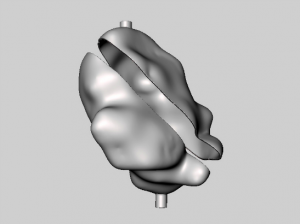A team of British cancer researchers are using 3D printing to create customized models of cancerous growths in the human body aimed at allowing doctors to target tumors for precise treatment.
They call them “phantoms,” 3D printed replicas of tumors and and organs which are constructed from CT scan data collected from patients during treatment. The plastic molds can be filled with liquid, and that lets doctors and technicians gauge the location and flow of radiopharmaceuticals within the body.
Radiopharmaceuticals are vessels (liquids or solids) which hold radioactive material. The preparations – injected into a vein, taken orally or placed directly within a body cavity – can be used to precisely target affected areas. The vessels are designed to deliver a dose of radiation high enough to kill cancer cells without causing unnecessary “collateral damage” to surrounding healthy tissue. Prostate cancer treatment radiopharmaceuticals, such as Xofigo, are the cutting edge in such treatment options. Essentially fast-decaying radium (Ra 223) dichloride, the drug is injected to treat prostate cancers resistant to medical or surgical treatments.
Dr. Glenn Flux, the head of radioisotope physics at the Institute of Cancer Research in London, says the use of such accurate, 3D printed models will aid doctors in fine-tuning dosing.
“If we personalize treatment according to the radiation dose delivered to the tumour, then we should have a better outcome,” Flux says. “Our research is aiming to find new ways to fine-tune the amounts of radiation given to patients as part of their treatment. There’s no reason why in the future, treatment planning can’t incorporate 3D printing technology to help improve radiation dosing for patients.”
Preliminary studies done by the team at ICR London can help map the exact position of a given tumor within a patient’s body, and initial tests have discovered that such models allowed the dose of radiation a patient has received to be calculated more accurately.
The work, funded by the NIHR Biomedical Research Centre at The Royal Marsden and The Institute of Cancer Research (ICR), also received support from the PhD program at the IRC.
The tumor replicas were constructed of plastic and printed by researchers at the Joint Department of Physics at the ICR and The Royal Marsden. The researchers say the models were once made by hand before the teams turned to 3D printing technology to streamline the process.
For the most part, the models are used in the treatment of thyroid cancer, adult neuroendocrine tumors, cases of childhood neuroblastoma and bone metastases which arise from cases of prostate cancer.
Dr. Jonathan Gear, a Clinical Scientist in the Joint Department of Physics at The Institute of Cancer Research and The Royal Marsden NHS Foundation Trust, a co-leader of the study, said the major challenge faced by the researchers was producing models that were both anatomically accurate and capable of monitoring the dose of radiation they received during treatment.
“We found that the printed replicas could give us information we couldn’t get from 2D scans – you will always get more information from a 3D model than a flat image,” Gear said.
Do you know of other innovative and novel ways 3D printing is being used to help doctors and scientists in their work? Please let us know and discuss the subject in the 3D Printed Radiopharmaceutical Models thread on 3DPB.com.
Subscribe to Our Email Newsletter
Stay up-to-date on all the latest news from the 3D printing industry and receive information and offers from third party vendors.
You May Also Like
Printing Money Episode 17: Recent 3D Printing Deals, with Alex Kingsbury
Printing Money is back with Episode 17! Our host, NewCap Partners‘ Danny Piper, is joined by Alex Kingsbury for this episode, so you can prepare yourself for smart coverage laced...
Insights from Cantor Fitzgerald on AM’s Q1 2024 Landscape
A recent survey by Cantor Fitzgerald sheds light on the persistent challenges within the additive manufacturing (AM) industry in the first quarter of 2024. Based on responses from 38 industry...
3D Printing Financials: Xometry’s Scaling up and Strong Start to 2024
Xometry (Nasdaq: XMTR) kicked off 2024 with strong results, boosting its marketplace and technology to new heights. Both revenue and gross margin soared, fueled by an expanding global network of...
3D Printing Financials: Desktop Metal Targets Recovery Amid Net Losses and Revenue Downturn
Despite facing a decline in revenue and the persistent challenges of a tight economic climate, Desktop Metal (NYSE: DM) is making strides toward operational efficiency. The first quarter of 2024...



































